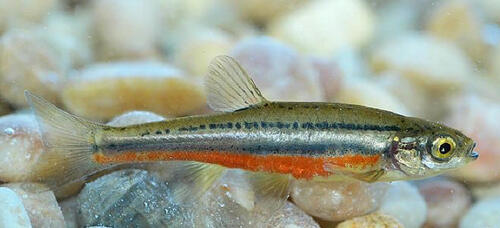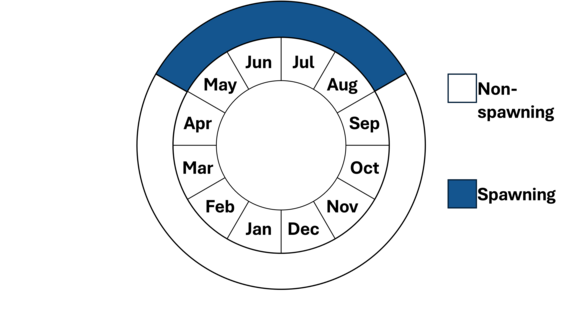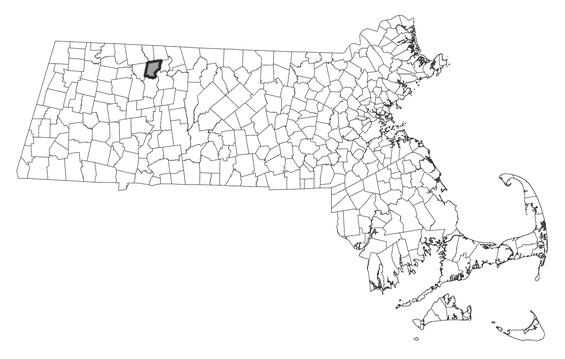- Scientific name: Chrosomus eos
- Species of Greatest Conservation Need (MA State Wildlife Action Plan)
- Endangered (MA Endangered Species Act)
Description

Northern redbelly dace (Chrosomus eos)
The northern redbelly dace can be distinguished from all other Massachusetts minnows by the presence of two longitudinal dark or dusky stripes along their sides and small scales that are almost invisible to the naked eye. The upper stripe is often broken into small dots or patches behind the dorsal fin, but the lower stripe is always complete. Other characteristics, such as the long, coiled intestine and the black peritoneum (lining of body cavity), are also helpful in identifying this fish. The lateral line is incomplete, and its mouth is small and oblique. They have 70 to 90 lateral line scales. This species averages 50 mm (~2 in) in total length. The lower sides and belly are white, silver, or yellow. During the breeding season, these areas on the males become brilliant red.
Life cycle and behavior

Northern redbelly dace begin spawning in spring and may continue as late as early August. They can spawn multiple times during a season. They lay non-adhesive eggs in filamentous algae; eggs hatch in 8 to 10 days at water temperatures of 21-27°C (~70-80°F). They may not reach maturity until their second or third summer and may live up to 8 years. Northern redbelly dace feed mainly on diatoms and filamentous algae, but also zooplankton and aquatic insect larvae. Their predators are thought to be other fishes, kingfishers, and mergansers.
Distribution and abundance
The northern redbelly dace range extends from the Northwest Territories and British Columbia, south to Colorado, and east to New York, Massachusetts, and north to Quebec and the Maritime provinces. In New England, the species occurs in Massachusetts, Vermont, New Hampshire, and Maine. In Massachusetts, the species occurs only in the Deerfield River watershed representing the southernmost extent of the species range in New England and may be considered a glacial relict. Northern redbelly dace has been typically observed in low abundances and has not been observed in over 20 years. More recent fish community surveys have failed to detect this species at its historical reaches and segments suggesting the species might be extirpated from Massachusetts. However, targeted survey effort for the species is needed to maximize species detection in order to support this conclusion.
The status of northern redbelly dace in Massachusetts remains uncertain. Northern redbelly dace is listed as endangered in Massachusetts. As with all species listed in Massachusetts, individuals of the species are protected from take (collecting, killing, etc.) and sale under the Massachusetts Endangered Species Act.

Distribution in Massachusetts. 1999-2024. Based on records in the Natural Heritage Database.
Habitat
Northern redbelly dace are generally found in quiet, cool, boggy streams and lakes; however, in Massachusetts they are found in clear streams and spring-fed seepage pools.
Healthy habitats are vital for supporting native wildlife and plants. Explore habitats and learn about conservation and restoration in Massachusetts.
Threats
Potential threats to northern redbelly dace include increased erosion and sedimentation, altered streamflows, channelization, loss of riparian vegetation, invasive riparian vegetation, and agricultural runoff.
Conservation
Survey and monitoring
Routine fish community sampling has failed to detect northern redbelly dace within historically occupied streams.
Management
Management for this species focuses on habitat protection and restoration such as improvements to streamflow, dam removal, culvert replacement, and riparian and streambank restoration.
Research needs
Targeted survey effort (e.g., eDNA, physical surveys) is needed to detect potential extant viable populations in the northern redbelly’s dace historical watershed. If still present on the Massachusetts landscape, population-level genetic analysis is warranted to estimate its genetic diversity and viability and compare to more northernly core populations to understand its distinctness. Efforts will inform an update to the species’ status.
References
Hartel, K.E., Halliwell, D.B., Launer, A.E. Inland Fishes of Massachusetts. Lincoln, MA: Massachusetts Audubon Society, 2002.
Contact
| Date published: | April 10, 2025 |
|---|